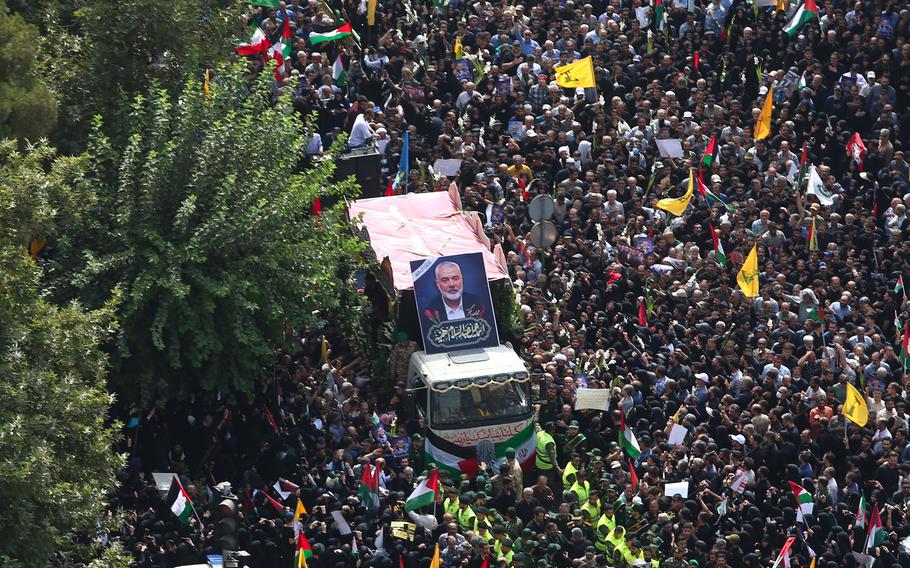
In this handout image from the Office of the Iranian Supreme Leader, people gather during a funeral procession for Ismail Haniyeh, the political leader of Hamas and his bodyguard who were killed in an assassination on Aug. 1, 2024, in Tehran, Iran. (Office of the Iranian Supreme Leader via Getty Images/TNS)
Iranian officials are signaling this week that an attack against Israel may not be imminent, pulling back for now from some of their harsher threats to avenge Hamas leader Ismail Haniyeh, who was killed last month in a blast at his guesthouse in Tehran.
Iran had repeatedly warned of a “devastating” reprisal to “punish” Israel for the assassination - but it later softened its rhetoric, and, in a statement Wednesday, the Iranian mission to the United Nations reinforced the government’s position that any response “must be carefully calibrated” to avoid affecting a potential cease-fire in the Gaza Strip.
Even Iran’s Islamic Revolutionary Guard Corps, the country’s most powerful security force, said that an attack might not come right away. “Time is at our disposal,” Brig. Gen. Ali Mohammad Naeini, the IRGC spokesman, said Tuesday, according to local media. “And the waiting period for this response could be long.”
The remarks appeared to reflect Iran’s desire to avoid a wider war as it deals with economic strife and a delicate political situation at home. Haniyeh’s killing, at a secure compound on July 31, was a stunning embarrassment for Iran’s security forces - but the country’s new reformist president just formed his government, and a conflict with Israel threatens to distract from his central campaign pledge of improving the economy.
On Wednesday, Iran’s hard-line parliament approved President Masoud Pezeshkian’s 19-member cabinet, which includes both reformists and conservatives, a move that the new leader said represents his “consensus” approach to governing.
During his campaign this summer, Pezeshkian, the first reformist to be elected president in more than two decades, called for greater engagement with the West and promised to address Iran’s spiraling economy and simmering public anger over the harsh enforcement of the country’s mandatory dress code for women.
Still, the election that brought him to power was fraught. Historically low turnout in the first round of voting in June forced the contest to a runoff, drawing out an electoral campaign that had already polarized and discouraged some voters.
But Iran’s domestic pressures are just one contributing factor to the “bind” the country now finds itself in, according to Gregory Brew, an Iran analyst at the Eurasia Group.
“Their dilemma is that they don’t know how to respond without starting a war,” he said, adding that “doing something that everyone sees as symbolic doesn’t solve the problem” of restoring deterrence with Israel.
Immediately after Haniyeh’s assassination, which came just hours after Israel killed a senior Hezbollah commander near Beirut, the region went on high alert. Israelis braced for a response, both from Iran and Lebanon, and the United States, a key ally of Israel, bolstered military assets in the Red Sea, Eastern Mediterranean and Gulf of Oman.
Despite Iran’s public statements vowing revenge, its private messaging was much more cautious. During meetings with leaders of allied militias, Iranian officials urged restraint - seeking to balance any show of force with the desire to avoid an all-out conflict.
The Biden administration also deployed senior diplomats to the region to contain the fallout, including a renewed push for a cease-fire agreement in Gaza, where a war has raged for more than 10 months.
This week, Secretary of State Antony Blinken shuttled between Israel, Egypt and Qatar on a mission to pressure Israel and Hamas to agree to a U.S.-sponsored proposal that would halt the fighting and see the release of Israeli hostages still in captivity.
The plan, which the administration describes as a “bridging proposal,” would also allow for displaced Palestinians to return to their homes in northern Gaza under Israeli supervision, and includes a scheduled withdrawal of Israeli forces from major population centers there.
The negotiations, which remain tense and have so far failed to produce an agreement, gave Iran the opportunity to climb down from the more bellicose statements, analysts said, and take a wait-and-see approach to cease-fire talks while still considering a response.
In April, Iran retaliated against Israel for a deadly strike on the Iranian Embassy complex in Damascus, which killed seven people, including senior military advisers. It launched its first direct attack on Israel, firing hundreds of missiles and drones toward Israeli territory - most of which were intercepted, including by the U.S. military.
This time, Iran will probably have to do something bigger or different, Brew said.
Iran’s mission to the United Nations also hinted that the response may take a different form.
“Perhaps when their eyes are fixed on the skies and their radar screens, they will be taken by surprise from the ground - or perhaps even by a combination of both,” the mission said in its statement.
“The timing, conditions, and manner of Iran’s response will be meticulously orchestrated to ensure that it occurs at a moment of maximum surprise,” the statement said.